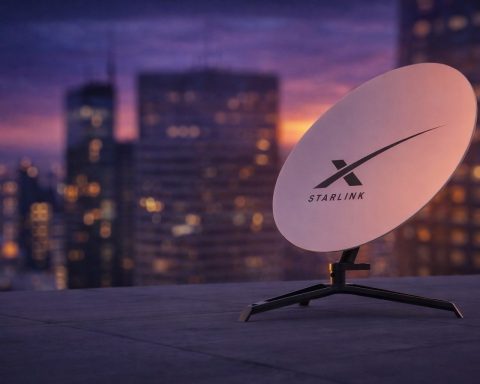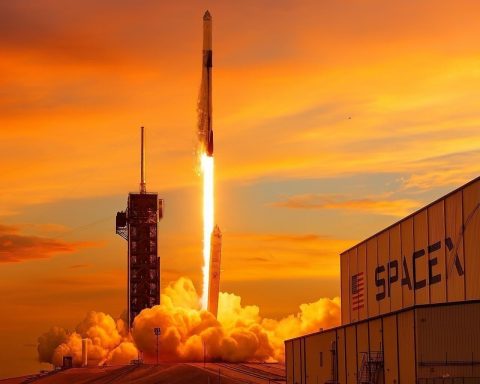- On Aug. 14, 2025, SpaceX launched two Falcon 9 missions 12 hours apart, first from Vandenberg with 24 Starlink satellites and then from Cape Canaveral with 28 Starlink satellites, with deployments confirmed and boosters recovered at sea (one on its 10th flight).
- These back-to-back flights brought SpaceX’s 2025 Falcon 9 count to 99 and pushed the Starlink megaconstellation to over 8,100 active satellites in orbit.
- California’s Coastal Commission unanimously vetoed SpaceX’s plan to raise Vandenberg’s annual Falcon 9 launches from 50 to 95, with the U.S. Space Force signaling a possible override and SpaceX suing the commission.
- ULA’s Vulcan Centaur launched the USSF-106 mission on Aug. 12 at 8:56 p.m. EDT from Cape Canaveral, carrying the Navigation Technology Satellite-3 (NTS-3) for the U.S. Space Force to test new PNT technologies.
- NTS-3 was built by L3Harris and is intended to advance military positioning, navigation, and timing with reprogrammable signals and advanced atomic clocks.
- Ariane 6 VA264, in a 2-booster configuration, launched Metop-SG A1 on Aug. 12–13, 2025 from Kourou to a Sun-synchronous orbit, delivering the ~4-ton Metop-SG A1 and Copernicus Sentinel-5 instrument.
- An upper-stage vent from Ariane 6 created a glowing spiral in the night sky observed across parts of North America during the mission.
- NASA’s James Webb Space Telescope detected a possible Saturn-mass exoplanet orbiting Alpha Centauri A about 4 light-years away, potentially in the habitable zone, later dubbed the “disappearing planet” after not appearing in early 2025 data.
- NASA notes Apollo seismic data combined with Lunar Reconnaissance Orbiter imagery to forecast Moonquakes and inform the design of Artemis-era lunar habitats.
- The Artemis Accords expanded to 56 nations with Senegal joining and India having joined in 2023; on Aug. 14, 2025, President Donald Trump signed an Executive Order to enable competition in the commercial space industry by streamlining regulations and licensing.
SpaceX’s Starlink Blitz – Two Launches in 12 Hours (and a Regulatory Twist)
SpaceX demonstrated its unprecedented launch cadence on Aug. 14 by launching two Falcon 9 missions just half a day apart [1]. In the early morning hours, a Falcon 9 lifted off from Vandenberg Space Force Base in California carrying 24 Starlink internet satellites; by 8:29 a.m. EDT the same day, another Falcon 9 roared from Cape Canaveral, Florida with 28 Starlink satellites [2]. SpaceX confirmed successful deployment of all satellites (“Deployment of 28 Starlink satellites confirmed,” the company posted on X) [3]. Both missions saw veteran first-stage boosters safely recovered at sea, one marking its 10th flight [4]. These back-to-back launches brought SpaceX’s 2025 launch count to 99 Falcon 9 flights, with over 8,100 active Starlink satellites now in orbit [5] – a staggering expansion of the Starlink megaconstellation.
However, even as SpaceX pushes boundaries in launch frequency, it faces headwinds on the regulatory front. On Aug. 14, California’s Coastal Commission unanimously vetoed SpaceX’s proposal to nearly double its allowed annual Falcon 9 launches from Vandenberg (from 50 up to 95) [6]. The state regulators previously opposed a smaller expansion last year, citing environmental oversight concerns. The U.S. Space Force – which operates Vandenberg – has signaled it may override the state, asserting federal primacy in launch operations [7]. SpaceX, for its part, has sued the commission over earlier objections, accusing it of singling out the company due to CEO Elon Musk’s politics [8]. This clash underscores the tension between SpaceX’s rapid growth and local regulatory limits, even as the company’s launch tempo breaks records.
New Vulcan Rocket Delivers Space Force’s Experimental Satellite
In a milestone for U.S. launch capabilities, United Launch Alliance’s Vulcan Centaur rocket flew its inaugural national security mission on Aug. 12 (reported Aug. 13–14). The heavy-lift Vulcan lifted off from Cape Canaveral at 8:56 p.m. EDT carrying the USSF-106 mission, which included the Navigation Technology Satellite-3 (NTS-3) payload for the U.S. Space Force [9] [10]. This is the first experimental navigation satellite the Pentagon has launched in nearly 50 years, meant to test new Positioning, Navigation and Timing (PNT) technologies like reprogrammable signals and advanced atomic clocks [11]. After a complex profile reaching geosynchronous orbit ~7 hours after liftoff, mission directors confirmed a successful deployment of the satellite.
Space Force officials hailed the debut flight. “It’s an exciting day for us as we launched the first NSSL [National Security Space Launch] flight of Vulcan, an outstanding achievement for ULA and the nation’s strategic space lift capability,” said Col. Jim Horne, the mission director [12]. The mission’s success marks a long-awaited new era for ULA, as Vulcan is set to gradually replace the venerable Atlas V and Delta IV rockets with domestically produced engines. NTS-3’s manufacturer, L3Harris, stressed the satellite’s importance for military needs: “The need for accurate and uninterrupted PNT has never been more essential to our warfighters… The successful launch of NTS-3 is the first step in updating 20th century technology to help address current threats,” said Ed Zoiss, President of L3Harris’ Space and Airborne Systems division [13]. With Vulcan’s first national security launch in the books, the U.S. is moving toward a more resilient and modernized launch fleet for defense payloads.
Europe’s Ariane 6 Triumphs with Weather Satellite (and Lights Up the Sky)
Europe’s new heavy-lift rocket, Ariane 6, notched a success on Aug. 12–13 with the launch of a cutting-edge meteorological satellite. At 9:37 p.m. local time Aug. 12 in Kourou, French Guiana (00:37 UTC Aug. 13), an Ariane 6 in its 2-booster configuration blasted off carrying Metop-SG A1, the first of Europe’s next-generation polar-orbiting weather satellites [14]. The launcher deployed the ~4-ton EUMETSAT satellite into a Sun-synchronous orbit about an hour later, where it will deliver advanced data for weather forecasting and climate monitoring. Metop-SG A1 also hosts the new Copernicus Sentinel-5 instrument to track atmospheric composition. This flight (VA264) was Ariane 6’s third overall and second operational mission, further proving out Europe’s Ariane 6 system after a decade of development.
European space leaders lauded the achievement. “Tonight, Arianespace has successfully launched EUMETSAT’s Metop-SG A1… This success pinpoints our dedication to ensuring Europe’s autonomous and reliable access to space while also supporting an ambitious environmental mission,” said Arianespace CEO David Cavaillolès [15]. Martin Sion, CEO of ArianeGroup, added that the launch “confirms the performance, reliability, and precision of Ariane 6”, reflecting progress as production of the next rockets ramps up [16]. EUMETSAT’s Director-General highlighted the satellite’s importance in an era of extreme weather: Europe’s new space asset will give “national weather services… sharper tools to save lives, protect property, and build resilience against the climate crisis,” he noted, emphasizing the international collaboration behind the mission [17].
In an eye-catching twist, the Ariane 6’s upper stage release of excess propellant created a glowing spiral in the night sky that surprised skywatchers across parts of the United States. As the rocket’s trajectory took it over North America during a fuel dump, many observers from Iowa to New York reported a slowly moving, swirling light overhead [18] [19]. Experts confirmed it was the Ariane’s vented fuel illuminated by sunlight – a rare spectacle that briefly went viral on social media. (A similar phenomenon has been seen after Falcon 9 launches in the past.) The spectacle aside, Ariane 6’s flawless launch is a major boost for Europe’s space ambitions, demonstrating its new flagship rocket can deliver on both commercial and scientific fronts.
China Ramps Up Megaconstellation Launches
China is aggressively expanding its “Guowang” satellite internet constellation, aiming to rival Starlink with a planned 13,000-satellite network. On Aug. 13, China launched the eighth batch of Guowang satellites, its fourth such launch in under three weeks [20]. A powerful Long March 5B rocket lifted off from Wenchang launch center at 2:43 p.m. local time carrying a group of 8–10 broadband satellites for Guowang [21] [22]. (The relatively low number of satellites per launch – compared to two dozen or more on SpaceX missions – is due to each Chinese satellite being quite large and massive.) The state-owned China SatNet company, created in 2021 to operate Guowang, declared the mission a “complete success” [23]. With this pace of launches, China is signaling its intent to fast-track a national LEO internet constellation, though it still has a long way to go – only 8 Guowang launches have occurred to date, versus hundreds for SpaceX’s Starlink [24].
In addition to government launches, China’s commercial space sector is making moves. Private launch firm LandSpace was expected to attempt a launch of its Zhuque-2E rocket around Aug. 14–15, carrying an unspecified payload to orbit [25]. LandSpace’s Zhuque-2 made headlines as the first methane-fueled orbital rocket developed outside the US, and a successful flight this week would further validate China’s burgeoning startup launch industry. These efforts, alongside state projects, underscore a fiercely competitive global race in satellite internet and launch services. China’s dual strategy – state megaconstellations and private rocket innovation – is quickly altering the landscape of the space industry in 2025.
Scientific Highlights: Webb Sniffs Out an Exoplanet and Moonquake Insights
It’s not all about rockets – new scientific discoveries also grabbed headlines. NASA’s James Webb Space Telescope (JWST) has found strong evidence of a giant exoplanet in the closest star system to Earth. In results unveiled Aug. 14, astronomers using Webb’s infrared eyes detected a possible Saturn-mass planet orbiting Alpha Centauri A, a Sun-like star just 4 light-years away [26]. The candidate planet appears to lie roughly 1–2 times Earth’s distance from its star, which would put it in the star’s habitable zone – though as a gas giant, it’s not likely to host life. This discovery is extraordinary in part because Alpha Centauri is a binary system with very bright stars; imaging a faint planet there pushed JWST to its limits. “With this system being so close to us, any exoplanets found would offer our best opportunity to collect data on planetary systems other than our own. Yet these are incredibly challenging observations to make… the operations team had to come up with a custom observing sequence, and their extra effort paid off spectacularly,” said Dr. Charles Beichman of NASA’s Exoplanet Science Institute [27]. Intriguingly, the object was visible in Webb data from Aug 2024 but not in early 2025, prompting researchers to dub it the “disappearing planet” and run simulations of possible orbits [28] [29]. If confirmed by further observations, this would become the closest exoplanet ever directly observed around a Sun-like star [30] – a landmark target for future studies by Webb and the upcoming Nancy Grace Roman Space Telescope.
Closer to home, scientists are revisiting Apollo-era data to safeguard tomorrow’s Moon explorers. In an update reported Aug. 14, NASA highlighted that Apollo seismic measurements, combined with high-resolution Lunar Reconnaissance Orbiter (LRO) imagery, are helping forecast “moonquakes” on the Moon [31]. While lunar quakes are harmless for short Apollo-style missions, they could affect the long-term habitats Artemis astronauts plan to build on the lunar surface. By analyzing how past quakes shook Apollo seismometers and mapping fault lines and tectonic features with LRO, researchers can predict how often quakes might occur and how strong they could be in specific regions. This research will inform the design of future Moon bases – ensuring structures can withstand the Moon’s occasional tremors. It’s a fascinating example of decades-old Moon samples and data finding new use in 2025, as NASA prepares to return humans to the Moon’s south pole in the coming years.
International Cooperation and Policy Developments
On the diplomatic front, global cooperation in space continues to deepen. NASA’s Artemis Accords – a non-binding framework for peaceful exploration – welcomed new members, bringing the total to 56 nations as of late July [32]. In the past few weeks, countries including Senegal signed on, aligning with principles on transparency, interoperability, and responsible behavior on the Moon and beyond. The broadening participation (spanning every continent) reflects a growing consensus on norms for lunar exploration and a desire for international partnerships in NASA’s Artemis program. Observers note that India’s successful Moon landing last year and its upcoming Gaganyaan human spaceflight are also fostering collaboration; India joined the Accords in 2023 and is seen as a key player in the new era of lunar exploration.
Meanwhile, the United States introduced a policy move aimed at bolstering its commercial space sector. On Aug. 14, U.S. President Donald Trump signed an Executive Order titled “Enabling Competition in the Commercial Space Industry,” with an eye to streamlining regulations and licensing for launches and satellite operations [33]. The order seeks to cut red tape and encourage innovation so that U.S. companies can accelerate deployment of new space technologies. “The FAA strongly supports President Trump’s Executive Order to make sure the U.S. leads the growing space economy… This order safely removes regulatory barriers so that U.S. companies can dominate […] space transportation and innovation,” said FAA Administrator Bryan Bedford in support of the move [34]. The executive action dovetails with other recent U.S. efforts (such as spectrum policy updates and export control tweaks) to maintain an edge in an increasingly crowded space industry.
Finally, amid rising anti-satellite weapon concerns, international forums are advancing norms to keep space peaceful. All 27 EU nations recently pledged not to conduct destructive ASAT tests, joining a U.S.-led moratorium that now includes dozens of countries [35]. While not a formal treaty, this political commitment – discussed at a U.N. working group concluding this summer – is aimed at curbing space debris from missile tests. It’s part of a broader push for space sustainability, alongside new U.N. guidelines on space traffic management under consideration. Together, these policy developments show that as humanity launches more satellites and plans crewed missions to the Moon and Mars, nations are also working (albeit gradually) to establish the rules of the road for space – ensuring the final frontier remains safe and accessible for all.
Sources: Space.com [36] [37] [38]; Reuters [39] [40]; Space Force (USSF) [41] [42] [43]; Design & Development Today [44]; Arianespace [45] [46]; EarthSky [47] [48]; Space.com [49] [50]; Space.com [51]; NextSpaceflight calendar [52]; ScienceDaily (NASA/JPL) [53] [54]; ScienceDaily [55] [56]; NASA Social Media [57]; NASA/UNOOSA [58]; NASA News Release [59]; SpaceNews [60].
References
1. www.space.com, 2. www.space.com, 3. www.space.com, 4. www.space.com, 5. www.space.com, 6. www.reuters.com, 7. www.reuters.com, 8. www.reuters.com, 9. www.spaceforce.mil, 10. www.spaceforce.mil, 11. www.spaceforce.mil, 12. www.spaceforce.mil, 13. www.designdevelopmenttoday.com, 14. newsroom.arianespace.com, 15. newsroom.arianespace.com, 16. newsroom.arianespace.com, 17. newsroom.arianespace.com, 18. earthsky.org, 19. earthsky.org, 20. www.space.com, 21. www.space.com, 22. www.space.com, 23. www.space.com, 24. www.space.com, 25. www.space.com, 26. www.sciencedaily.com, 27. www.sciencedaily.com, 28. www.sciencedaily.com, 29. www.sciencedaily.com, 30. www.sciencedaily.com, 31. x.com, 32. en.wikipedia.org, 33. www.nasa.gov, 34. www.nasa.gov, 35. spacenews.com, 36. www.space.com, 37. www.space.com, 38. www.space.com, 39. www.reuters.com, 40. www.reuters.com, 41. www.spaceforce.mil, 42. www.spaceforce.mil, 43. www.spaceforce.mil, 44. www.designdevelopmenttoday.com, 45. newsroom.arianespace.com, 46. newsroom.arianespace.com, 47. earthsky.org, 48. earthsky.org, 49. www.space.com, 50. www.space.com, 51. www.space.com, 52. www.space.com, 53. www.sciencedaily.com, 54. www.sciencedaily.com, 55. www.sciencedaily.com, 56. www.sciencedaily.com, 57. x.com, 58. en.wikipedia.org, 59. www.nasa.gov, 60. spacenews.com










